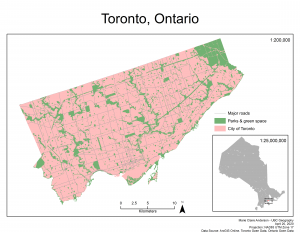The Government of Canada states: “mental health is the state of your psychological and emotional well-being. It is a necessary resource for living a healthy life and a main factor in overall health. It does not mean the same thing as mental illness. However, poor mental health can lead to mental and physical illness” (2015). As such, having poor mental health can effect every aspect of a persons daily life. Poor mental health is a state that will undoubtably affect everyone at different scales, and for different reasons at some point in their life time and is becoming an increasingly popular topic of discussion. A person’s mental health can be influenced by a limitless number of factors including: physical environment, relationships, physical health, time of day, age, etc. At its extreme, poor mental health can result in emergency situations which require emergency department visits or hospitalizations. Data on such extremes has been gathered for the City of Toronto, by neighbourhood, for the years of 2015/2017.
Gruebner et al. (2017) discuss that there are social risk factors for mental health in cities, the proposed risk factors are similar to those of the Ontario Marginalization Index. For this reason, factors within the index will be investigated in conjunction with a number of other associated socio-economic variables. To explore these variables in relation to mental health and addiction related hospitalizations and ER-visits a series of spatial analyses will be conducted, including correlation analysis, exploratory regressions, Ordinary Least Square (OLS) regressions, Spatial Autocorrelation (Moran’s I), Geographically Weighted Regressions (GWR) and a brief network analysis. Influencing the methodological choices made for the purpose of this project was Cabrera-Barona et al. (2015) who used Moran’s I values and GWR analysis to investigate relationships between health factors and socio-economic factors across Quito City in Ecuador. In addition to, Liu et al. (2019) who used Moran’s I values, OLS regression analysis and GWR analysis to investigate the unequal distribution of medical facilities in rural areas of Henan, China.
Study Area
The area of investigation is Toronto, Ontario. Toronto is a major Canadian city which lies on the edge of Lake Ontario. In 2016, Toronto’s population of individuals over 15 years old was approximately 2.4 million. The study unit for the purpose of this research will be neighbourhood, of which Toronto has 140.

Research Questions
- What variables have a relationship with mental health and addiction related hospitalizations/emergency department visits in Toronto, ON?
- Are there neighbourhoods in Toronto, ON that are at risk of higher mental health and addiction related hospitalizations/emergency department visits?
- Is there fragmentation of mental health resource facilities within Toronto?
Explanatory Variables
- Population over 15 years old – both sexes
- Population over 20 years old – both sexes
- Total number of multi-parent families
- Total number of single parent families
- Instability*
- Depravation*
- Dependency*
- Ethnic concentration*
- Employment
- Debt risk score
- Housing cost
*Scores based of the 2016 Ontario Marginalization Index